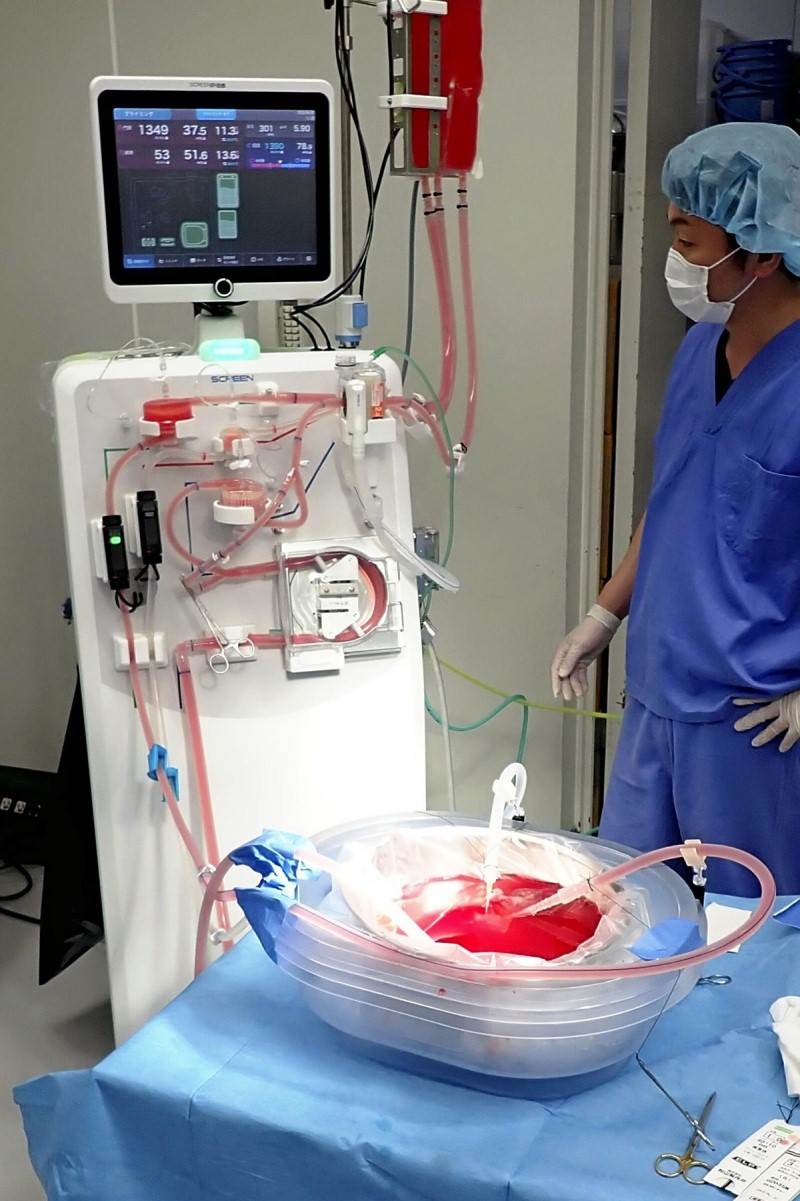Nagasaki Univ. Team Plans Clinical Test to Preserve Liver for Longer Time for Transplant Purposes

A device being developed by Nagasaki University and other bodies is seen. A pig’s liver is in the center of the device.
16:26 JST, May 29, 2024
A research team comprising Nagasaki University and other entities is planning to conduct clinical research as early as next year in which a special device is used to circulate a preservative fluid containing oxygen and other substances in an extracted liver before being transplanted to a patient, The Yomiuri Shimbun has learned.
The device has the advantage of extending the period of time that livers can be preserved for transplant. It has been learned that many transplant facilities declined to accept organs mostly due to insufficient systems and manpower. This technology is expected to improve treatment systems at hospitals.
Currently, organs removed from brain-dead patients are soaked in a preservative fluid and transported in ice-filled coolers. However, the time that organs can be kept in a suitable state for transplant is limited to four hours for hearts, eight hours for lungs and 12 hours for livers.
As a result, even if transplant facilities receive many requests to accept organs, there are often cases in which those facilities decline to accept them because they are unable to provide enough personnel and beds in the limited time available.
The university, Screen Holdings Co., a Kyoto-based machinery manufacturer, and other entities have developed a device that connects a tube to a blood vessel in a removed liver and circulates a preservative fluid. By continuously supplying oxygen and nutrients to the organ at low temperatures, the device can extend the preservation time of the organ by several hours and is expected to improve the organ’s function.
In the planned clinical study, the preservative fluid will be circulated for up to three hours prior to liver transplant surgery at Nagasaki University Hospital to verify the safety and effectiveness after the transplant. Based on the results of the study, the research team aims to apply for approval as a medical device.
This technology is already widely used overseas.
The newly developed device does not require complicated operational procedures and is relatively easy to manage.
“If we can preserve organs for longer periods of time, we can expect to reduce the burden [on doctors and others at transplant facilities], for example, by moving transplant operations planned late at night into the next morning,” said Akihiko Soyama, an associate professor at Nagasaki University. Soyama, who specializes in transplant and gastrointestinal surgery, heads the team.
"Science & Nature" POPULAR ARTICLE
-

Mass Oyster Die-Offs Confirmed in Japan’s Seto Inland Sea; High Water Temperature Cited as Primary Cause
-

Genome Study Reveals Milestone in History of Cat Domestication
-

Big Leap in Quest to Get to Bottom of Climate Ice Mystery
-

Security Camera Footage Vulnerable to Outside Access; Investigation Finds 3,000 Pieces Exposed Online
-

Paws on Parade: Nairobi’s Dogs Dazzle at ‘Pawchella’
JN ACCESS RANKING
-

Keidanren Chairman Yoshinobu Tsutsui Visits Kashiwazaki-Kariwa Nuclear Power Plant; Inspects New Emergency Safety System
-

Imports of Rare Earths from China Facing Delays, May Be Caused by Deterioration of Japan-China Relations
-

University of Tokyo Professor Discusses Japanese Economic Security in Interview Ahead of Forum
-

Japan Pulls out of Vietnam Nuclear Project, Complicating Hanoi’s Power Plans
-

Govt Aims to Expand NISA Program Lineup, Abolish Age Restriction























